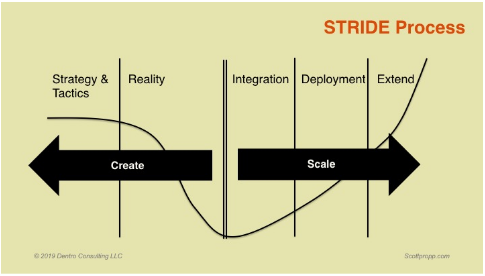Growth projects suffer from being underled and over managed precisely because it takes us to an uncomfortable place for strong operational leaders.
I was speaking to a group of senior leaders during a recent workshop on the topic of the STRIDE journey that every significant growth project follows during its execution. As we’ve discussed previously, STRIDE is a five-phase journey map for executing growth projects based on Joseph Campbell’s work around the hero’s journey. For more on STRIDE, see my blog posts here, here, and here.
 There are two zones in STRIDE: the work to create and the work to scale. It is in the transition (aka, the hurdle), where a great deal of value is either created or lost. The work is so very different, yet we treat the hurdle between the two steps as a linear handoff. The stakes of getting it right are quite simply the projected return on the project, which is typically millions of dollars.
There are two zones in STRIDE: the work to create and the work to scale. It is in the transition (aka, the hurdle), where a great deal of value is either created or lost. The work is so very different, yet we treat the hurdle between the two steps as a linear handoff. The stakes of getting it right are quite simply the projected return on the project, which is typically millions of dollars.
If we are to traverse this hurdle successfully, we need to better understand the skills that are required on each side of the map:
- Scaling & Optimization: The right-hand side of the map represents the comfort zone for most leaders in larger firms. The Complete Growth leader styles that are most active here are the Anchor and Catalyst, as they have a deep process background and a propensity for being able to complete action on an operation at scale. The leadership style is the classic Shewhart Cycle: Plan, Do, Check and Act.
- Creation & Discovery: The left-hand side demands a different set of skills. This is the domain of the Architect and Catalyst, who bring foresight and intuition to the table and are not afraid to experiment to gain more data.
Taking action on incomplete data is very uncomfortable for our Anchors, but is absolutely needed to make progress in the face of complexity. It is precisely this skill – taking reasonable actions in the face of ambiguity – that is required to move beyond the gridlock that is the hurdle.
This hurdle represents a power shift from the creative team to the operations team. This shifts the intent of the work, the power structure and the goals. This hand-off is typically very difficult, with projects frequently getting lost in the gap – never to be seen again.
What Steps are Needed to Overcome the Hurdle?
- Develop the overarching sponsorship for the program prior to the deployment of the team. This means that the mini Board of Directors for the program must contain the leaders who are stakeholders for both the creative work and scale.
- Develop a universal value proposition. Much of the hurdle is built by the people not associated with the project that don’t have a line of sight to why they should place precious resources into a “development” project. By building a business case that serves the “investor” in the firm, the project will have a much easier time going through the gap.
- Develop a truly cross-functional team. This means that the leader must be a respected member of one side of the firm or the other, and the workgroup needs to have participation from people who are strong in their respective disciplines. This can be done by doing a “Complete Growth Leader” capacity assessment and making sure the team is diverse in makeup.
There is great power in setting the right expectations at the outset of a project, and then building a strong, diverse group that can achieve those expectations. Knowing at the outset that the hurdle is coming helps leadership do the work to guide out the 78 percent of firms that fall short.
If you would like to talk about establishing a cross-functional team that delivers, please email me or use this link to set up time for a short discussion.
Related posts you can benefit from…



